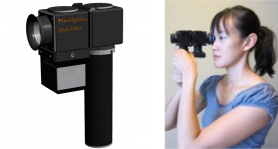Evaluation of a low-cost wavefront aberrometer for measuring refractive errors

| AUTHORS | |
| JOURNAL | Investigative Ophthalmology & Visual Science, Vol.55, Issue 13, April 2014 |
| ABSTRACT | Purpose: To evaluate the performance of a low-cost wavefront aberrometer in measuring refractive errors.
Results: For the 35 subjects, the range of spherical equivalent (SE) refractive error measured by subjective refraction was -6.50 to +3.63 D. The correlations between the SE measured objectively and subjectively were R = 0.96 for the prototype and R = 0.97 for the autorefractor. The average SE error of the prototype compared to subjective refraction was 0.54 ± 0.54 D, versus 0.40 ± 0.46 D for the autorefractor. The average errors of the J0 and J45 power vectors were 0.16 ± 0.22 D and 0.11 ± 0.11 D for the prototype and 0.13 ± 0.09 D and 0.08 ± 0.07 D for the autorefractor compared to subjective refraction. Conclusions: The prototype wavefront aberrometer performed similarly to a high-end open-field commercial autorefractor in objective refraction when using subjective refraction as the gold standard. The prototype performed worst on subjects with anisometropia (n=2), likely due to cross-coupled accommodation. Future improvements in the prototype algorithm can improve its accuracy in measuring refractive errors. An easy-to-use and low-cost autorefractor, such as the one evaluated here, may be beneficial for improving eye care in low-resource settings. |
| LINK | http://iovs.arvojournals.org/article.aspx?articleid=2268070&resultClick=1 |



